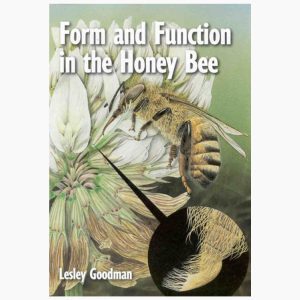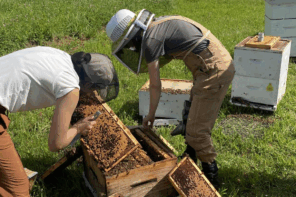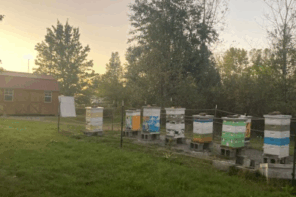 Kim Flottom
Kim Flottom
Form and Function in the Honey Bee, by Lesley Goodman. Published by Northern Bee Books and IBRA. Available on Amazon or from Northern Bee Books. 234 pages, color, paperback, 340 illustrations, $50 from Amazon.
The International Bee Research Association (commonly known as IBRA), and Northern Bee Books have together released a new edition of an outstanding book titled Form and Function in the Honey Bee, by Lesley Goodman. It was originally published by IBRA, but after it went out of print, they weren’t in a position to reprint so it has been missing for a bit.
Dr. Lesley Goodman, the author, completed her PhD work at Liverpool University, moving on to become a reader in Zoology at Queen Mary University in London until her retirement in 1996. Her research interests were primarily in the fields of neurobiology and insect physiology, specializing in honey bee flight and visual systems. Her special interest was in how insect thoracic flight motor machinery was influenced by commands from the brain, and she used honey bees to map the route of visual input to certain flight motor neurons.
Her work with bee scientists and beekeepers led her to produce this book that is readable by both non-scientists and students. Though incomplete when lung cancer overtook her work, she set up a fund to ensure the book was completed and published exactly as she intended. It was completed by Professor Richard Cooter, chair of the L. J. Goodman Insect Physiology Trust, and Dr. Pamela Munn, then Deputy Director of IBRA, who finally published the book in 2003. Lesley’s goal was to describe some of the topics that would attract a wide audience rather than a smaller group of insect specialists, and in my opinion she did exactly that. That remains the goal in this edition by contributors and the publishers.
In my office while editor of Bee Culture, were three reference books on my desk I used almost exclusively: Lesley’s book, the most current ABC and XYZ of Bee Culture, which, at that time, was edited by Dr. Shiminuki, Ann Harman and myself, and the most recent Hive and The Honey Bee, which then ABJ editor Joe Graham put together. Between those three, I could find almost anything honey bee, beekeeping, insects, flowers or whatever I needed. The current ABC, edited by Keith Delaplane and Lesley’s book are the two that sit on my desk now.
The book covers, essentially, the form, or anatomy, and the functions of the various anatomical parts she looks at. Basically, it’s an anatomy and physiology book looking at honey bees. It’s a big book in every way. It measures 12 inches by 8.25 inches, has 221 pages, over 340 diagrams, paintings, SEM photos and line drawings.
There are nine chapters, but each is a PhD’s worth of information.
The first studies the antennal sense organs, sorting out the sense of smell and the olfactory receptors, how tasting works for bees, sensing humidity, temperature and carbon dioxide, how the antennae work with hearing and finally, using them to interpret the dance language.
Next comes vision, looking closely at the compound eye, how colors are seen, or not, and using polarized light to navigate to and from anywhere they happen to be. Chapter three is short and to the point looking at the ocelli, or the simple eyes.
Chapter four focuses on how gravity affects the bees, and, what organs are used to measure this force. Neck hairs, petiole hairs and leg hairs seem to make this work.
Mouth parts are next. All the mouth parts and what each part does. And how do bees drink, anyway? You’ll find out here.
There’s a short chapter on collecting pollen, followed by a chapter on breathing, getting oxygen to every cell that needs oxygen, all of the time.
Flight was one of Goodman’s specialties and it shows in chapter seven. She looks at the evolution of flight, aerodynamics, structure of wings, why there are pairs of wings, how they are moved, which requires studies in detail of the anatomy of the thorax, flight muscles, distances, mating flights and muscle temperatures allowing flight.
Chapter eight looks at the pheromones of bees. Nasonov, queen, tarsal, glands, footprint pheromone and all the rest, and beeswax… making it, its composition, getting it outside the body and then comb building.
Her book finishes with defending the colony – the sting, venom, lancet movement, alarm pheromone and why the whole apparatus is so complicated.
If there’s something you want to know about honey bee anatomy or physiology, you will find it in this book, beautifully detailed in art, SEM’s or line drawings. It’s the only book you will need.
Form and Function is available from Northern Bee Books or Amazon. Check it out.









